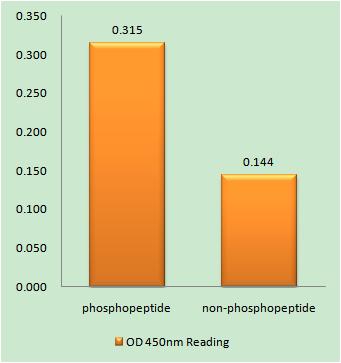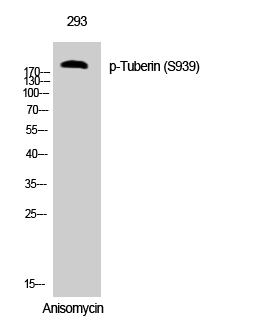
Catalog: KA1346C
Size
Price
Status
Qty.
96well
$470.00
In stock
0
Add to cart


Collected


Collect
Main Information
Reactivity
Human, Mouse, Rat
Applications
ELISA
Conjugate/Modification
Phospho
Detailed Information
Storage
2-8°C/6 months,Ship by ice bag
Modification
Phospho
Detection Method
Colorimetric
Related Products
Antigen&Target Information
Gene Name:
TSC2 TSC4
show all
Other Name:
TSC2 ;
TSC4 ;
Tuberin ;
Tuberous sclerosis 2 protein
TSC4 ;
Tuberin ;
Tuberous sclerosis 2 protein
show all
Background:
alternative products:Additional isoforms seem to exist. Experimental confirmation may be lacking for some isoforms,disease:Defects in TSC2 are a cause of lymphangioleiomyomatosis (LAM) [MIM:606690]. LAM is a progressive and often fatal lung disease characterized by a diffuse proliferation of abnormal smooth muscle cells in the lungs. It affects almost exclusively young women and can occur as an isolated disorder or in association with tuberous sclerosis complex.,disease:Defects in TSC2 are the cause of tuberous sclerosis complex (TSC) [MIM:191100]. The molecular basis of TSC is a functional impairment of the tuberin-hamartin complex. TSC is an autosomal dominant multi-system disorder that affects especially the brain, kidneys, heart, and skin. TSC is characterized by hamartomas (benign overgrowths predominantly of a cell or tissue type that occurs normally in the organ) and hamartias (developmental abnormalities of tissue combination). Clinical symptoms can range from benign hypopigmented macules of the skin to profound mental retardation with intractable seizures to premature death from a variety of disease-associated causes.,function:Implicated as a tumor suppressor. May have a function in vesicular transport, but may also play a role in the regulation of cell growth arrest and in the regulation of transcription mediated by steroid receptors. Interaction between TSC1 and TSC2 may facilitate vesicular docking. Specifically stimulates the intrinsic GTPase activity of the Ras-related protein RAP1A and RAB5. Suggesting a possible mechanism for its role in regulating cellular growth. Mutations in TSC2 leads to constitutive activation of RAP1A in tumors.,online information:TSC2 mutation db,PTM:Phosphorylation at Ser-1387, Ser-1418 or Ser-1420 does not affect interaction with TSC1.,similarity:Contains 1 Rap-GAP domain.,subcellular location:At steady state found in association with membranes.,subunit:Interacts with TSC1 and HERC1; the interaction with TSC1 stabilizes TSC2 and prevents the interaction with HERC1. May also interact with the adapter molecule RABEP1. The final complex contains TSC2 and RABEP1 linked to RAB5 (Probable). Interacts with HSPA1 and HSPA8.,tissue specificity:Liver, brain, heart, lymphocytes, fibroblasts, biliary epithelium, pancreas, skeletal muscle, kidney, lung and placenta.,
show all
Function:
embryonic epithelial tube formation, neural tube formation, neural tube closure, regulation of cell-matrix adhesion,morphogenesis of an epithelium, acute inflammatory response, protein complex assembly, negative regulation of protein kinase activity, protein targeting, protein import into nucleus, intracellular protein transport, endocytosis,nucleocytoplasmic transport, chemotaxis, defense response, acute-phase response, inflammatory response, cell surface receptor linked signal transduction, enzyme linked receptor protein signaling pathway, transmembrane receptor protein tyrosine kinase signaling pathway, intracellular signaling cascade, protein kinase cascade, heart development, behavior, locomotory behavior, protein localization, negative regulation of cell proliferation, regulation of cell size, response to wounding, embryonic development ending in birth or egg hatching, negative regulation of signal transduction, membrane invagination, regulation of protein kinase cascade, negative regulation of cell communication,negative regulation of protein kinase cascade, regulation of cell-substrate adhesion, primary neural tube formation,regulation of phosphoinositide 3-kinase cascade, negative regulation of phosphoinositide 3-kinase cascade, protein transport, membrane organization, vesicle-mediated transport, morphogenesis of embryonic epithelium, protein import, regulation of phosphate metabolic process, neural tube development, cell projection organization, regulation of endocytosis, regulation of Wnt receptor signaling pathway, regulation of cell adhesion, negative regulation of Wnt receptor signaling pathway, regulation of TOR signaling pathway, negative regulation of TOR signaling pathway,regulation of actin filament bundle formation, regulation of cellular component size, regulation of actin cytoskeleton organization, regulation of actin filament-based process, regulation of organelle organization, protein localization in organelle, negative regulation of kinase activity, protein localization in nucleus, cellular protein localization, tube lumen formation, tube morphogenesis, tube development, regulation of cell proliferation, regulation of phosphorylation,taxis, chordate embryonic development, positive regulation of catalytic activity, negative regulation of catalytic activity,regulation of GTPase activity, regulation of MAP kinase activity, negative regulation of MAP kinase activity, protein kinase B signaling cascade, positive regulation of GTPase activity, regulation of kinase activity, macromolecular complex subunit organization, regulation of cellular component biogenesis, negative regulation of molecular function,positive regulation of molecular function, establishment of protein localization, negative regulation of cell size,regulation of protein kinase activity, regulation of insulin receptor signaling pathway, intracellular transport, insulin-like growth factor receptor signaling pathway, embryonic morphogenesis, tissue morphogenesis, regulation of epithelial cell proliferation, negative regulation of epithelial cell proliferation, positive chemotaxis, regulation of small GTPase mediated signal transduction, nuclear transport, nuclear import, regulation of phosphorus metabolic process, protein oligomerization, protein homooligomerization, protein heterooligomerization, regulation of hydrolase activity,regulation of transferase activity, positive regulation of hydrolase activity, negative regulation of transferase activity,regulation of stress fiber formation, regulation of cytoskeleton organization, regulation of cell cycle, regulation of focal adhesion formation, regulation of protein kinase B signaling cascade, negative regulation of protein kinase B signaling cascade, epithelium development, epithelial tube morphogenesis, tube closure, regulation of vesicle-mediated transport, macromolecular complex assembly, protein complex biogenesis, cellular macromolecule localization,
show all
Cellular Localization:
Cytoplasm. Membrane; Peripheral membrane protein. At steady state found in association with membranes.
show all
Signaling Pathway
Cellular Processes >> Transport and catabolism >> Autophagy - animal
Cellular Processes >> Cell growth and death >> p53 signaling pathway
Cellular Processes >> Cell growth and death >> Cellular senescence
Organismal Systems >> Endocrine system >> Insulin signaling pathway
Organismal Systems >> Endocrine system >> Thyroid hormone signaling pathway
Organismal Systems >> Aging >> Longevity regulating pathway
Environmental Information Processing >> Signal transduction >> Phospholipase D signaling pathway
Environmental Information Processing >> Signal transduction >> PI3K-Akt signaling pathway
Environmental Information Processing >> Signal transduction >> AMPK signaling pathway
Environmental Information Processing >> Signal transduction >> mTOR signaling pathway
Reference Citation({{totalcount}})
Catalog: KA1346C
Size
Price
Status
Qty.
96well
$470.00
In stock
0
Add to cart


Collected


Collect
Recently Viewed Products
Clear allPRODUCTS
CUSTOMIZED
ABOUT US
Toggle night Mode
{{pinfoXq.title || ''}}
Catalog: {{pinfoXq.catalog || ''}}
Filter:
All
{{item.name}}
{{pinfo.title}}
-{{pinfo.catalog}}
Main Information
Target
{{pinfo.target}}
Reactivity
{{pinfo.react}}
Applications
{{pinfo.applicat}}
Conjugate/Modification
{{pinfo.coupling}}/{{pinfo.modific}}
MW (kDa)
{{pinfo.mwcalc}}
Host Species
{{pinfo.hostspec}}
Isotype
{{pinfo.isotype}}
Product {{index}}/{{pcount}}
Prev
Next
{{pvTitle}}
Scroll wheel zooms the picture
{{pvDescr}}


















